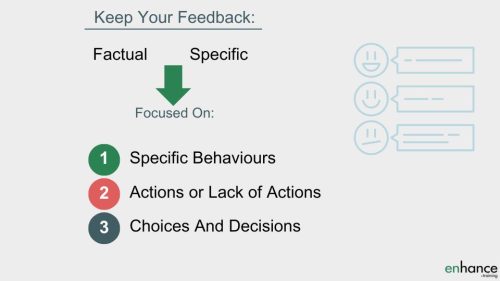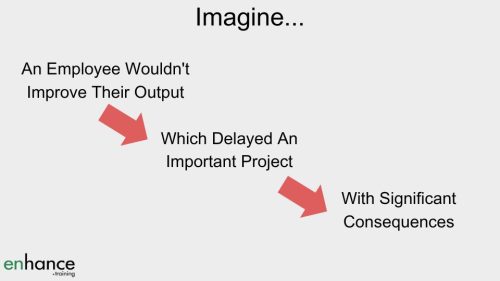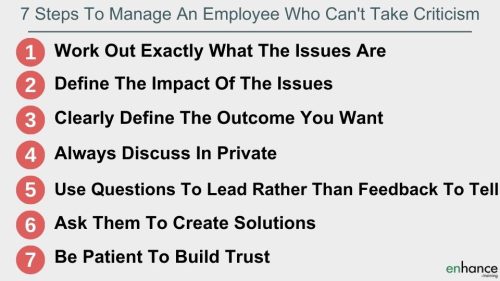7 Steps To Manage An Employee Who Can’t Take Criticism

An employee who can’t take criticism or who won’t accept feedback can be very difficult to manage. When everything is going well, when the employee doesn’t take feedback, it is an annoyance not a major issue.
When aspects of their work, behaviour, choices or actions are not going well, then the employee who refuses to accept criticism can quickly become a major issue to you the manager and to the team as a whole.
Imagine if an employee wouldn’t improve their output, which in turn delayed an important project with significant consequences for the business… there would be a lot of angry people putting a lot of pressure on you and the rest of the team.
The 5th and 6th steps are about coaching the other person to explore the issues rather than telling them your views. This takes longer but is usually a lot more effective in creating change with employees who can’t take criticism.
7 steps to manage an employee that can’t take criticism
- Work out exactly what the issues are
- Define the Impact of the issues
- Clearly define the outcome you want
- Always discuss in private
- Use questions to lead rather than feedback to tell
- Ask them to create solutions
- Be patient to build trust
Watch on YouTube
Listen on Podcast
When managing any employee, one of the most important things to keep in mind is that every person and situation is different and so you have to flex what you do to the person and the situation.
The first three steps are preparation steps. Do these well and the actions you take will be a lot easier to do and be more effective. Don’t prepare well and you can easily damage relationships and trust. It is not easy to repair damage to trust so please prepare well.
The first step for employees who can’t take criticism is to Work out exactly what the issues are
By being really clear what the issues are and collecting examples, you can avoid appearing to give your feedback as an opinion. The more you can keep your feedback factual, specific, and focused on:
- Specific behaviours
- Actions or lack of actions
- Choices and decisions
The easier it will be to discuss the issues without appearing to criticise them as individuals.
Be specific when detailing what the issues are. An example might be:
Yesterday on Tuesday, Bill shouted at Lisa, using an aggressive tone of voice in front of the whole team and called her stupid. Lisa looked very upset, with shrinking body language and at least three team members looked very disapproving and uncomfortable at the display.
This is very different from:
I didn’t like the way Bill shouted at Lisa yesterday.
Being specific with the issues helps you to come up with much more specific questions to ask the person who can’t take criticism. Specific questions are harder to avoid and helps to get them talking.

Define the Impact of the issues
When you are providing negative feedback, you are in effect asking for change. Change requires effort and to put that effort in, a person needs a personal reason.
Link the specific issues you have to specific impacts on
- Individuals
- Teams and
- The Business
Impacts can be described in many ways. Some examples might be:
- Because of X decision you made, we as a team lost three weeks, which in turn…
- The impact of you shouting at Lisa, is a damaged relationship, anger, hurt which will translate into a lower level of trust and teamwork, which in turn…
Use your judgement and be realistic. Do not underplay or overplay the impacts.
Then work out how the impacts to others and the business may feed through to impact the individual.
Again, when you are clear on the chain of impacts, you can ask better leading questions to get the employee who won’t accept feedback thinking through the impacts.

The third step for employees who can’t take criticism is to Clearly define the outcome you want
Defining the outcome in terms of the change you want from the person in question. For Bill shouting at Lisa, the changes might include:
- Helping Bill to communicate more constructively his own anger, frustration and annoyance
- Ensuring Bill does not shout at Lisa or any other team members
- Allowing the team to see me taking action on Bill’s shouting without betraying confidentiality.
Being clear on the outcome you want creates a focal point and goal for your subsequent conversations with the employee who can’t take criticism.

Always discuss in private – The fourth step
Praise publicly, but you should always keep any criticism firmly to private situations.
Book a meeting room. Take a short walk. Use your next one-on-one meeting. Create an opportunity to have a private conversation without delaying unnecessary.
Aim to be relaxed and to keep them relaxed. I try to go for informal rather than formal in most situations.
Always have conversations criticising actions, choices, or behaviour in private. This is even more important for employees who can’t take criticism.
The fifth step to manage an employee who can’t take criticism is to Use questions to lead rather than feedback to tell
What to say to an employee who can’t take criticism is a challenge. I use questions to get the other person talking and concentrate on listening and understanding their position.
During your preparation steps, you have been working on a list of questions you can ask to focus the conversation on the points you want them to cover.
The best way I have found for how to give feedback to someone who hates getting it is by asking targeted questions and leading them to give themselves realistic feedback.
Using questions is a lot less confrontation and involves much less negative emotion than telling the other person what you think. It is my default approach for any emotionally charged situation or when an employee won’t accept feedback.
An Example:
Of giving negative feedback to an employee through using questions. I have outlined a conversation towards the difficult end of what is common in these situations:
Manager – Bill, can you tell me how you were feeling just before and during your talk with Lisa yesterday?
Bill – what talk.
Manager – I, and the rest of the team saw you stand up at your desk and state a few things to Lisa yesterday. I think it was around 1pm.
Bill – I can’t remember
Manager – You looked very emotional and had strong views. I would be amazed if you didn’t remember it.
Bill – okay, I do remember it. I just don’t want to talk about it.
Manager – I appreciate that talking about it might not be easy. I have to talk about it with you. It is part of my job as a manager. I would like to help you come up with different ways to manage that situation. Please would you tell me about what you were thinking and feeling.
Bill – okay … and the conversation continues
Be diplomatic and considerate, and remain direct so that you don’t let the other person off the hook. Using questions, a calm tone of voice and interested body language does wonders to get other people talking.
As always, use your judgement and remain aware of the non-verbal feedback from the person in front of you. They will talk to you when they trust you and You have to earn that trust. Demonstrate that you have their best interests at heart.
The sixth step for employees who won’t accept feedback Ask them to create solutions
Another very effective way of getting employees who won’t accept feedback to take in, understand and accept feedback is if you ask them to help you create solutions to the feedback issue.
For instance, you could ask them to help you understand the best way to give them feedback. An example might be:
Manager – Bill, I could really use your help. Would you mind helping me?
Bill – what do you want help with
Manager – I am really struggling to understand the best way to give you useful feedback. I don’t want you to get left behind as the team improves. How would you prefer me to approach helping you?
Bill – I don’t really understand what you mean
Manager – Can you coach me or tell me how best to speak to you about areas that would benefit you to improve?
Bill – I think you know that I don’t like getting feedback. I find it difficult to receive. I would appreciate you coaching me through examples so that I realise what I am doing well and what I am not. This works a lot better for me than you telling me directly. Would you mind taking that approach.
Manager – Thank you for helping me. I really appreciate it. I will do my best to use a coaching approach… the conversations continues with the manager asking questions and listening.
Asking for their help, puts control in their hands. They decide to help or not. This increases the feeling of safety and I think it helps build trust.
If they are not ready to help you, don’t push it. Return to the conversation at the next sensible opportunity. One thing you can’t do is ignore or forget about the issues – you must keep signalling it is important to you to resolve with them.
The seventh step to manage an employee who can’t take criticism is to Be patient to build trust
You build trust by letting the employee who can’t take criticism choose the pace at which they are willing to let you help them. You build trust by doing all you can to help them personally. By helping them, you should be helping the team, which in turn helps you personally.
You can’t demand trust or tell someone to trust you. You have to earn trust. So be patient, and make sure all your decisions, actions and behaviours are aligned to building trust with everyone on your team and in particular any employees that won’t accept feedback.
Don’t ignore or forget about the issues – you must keep signalling it is important to you to resolve with them by carefully asking good relevant questions to get thinking and talking.

In summary
We have covered the best way I know for what to do when your employee doesn’t take feedback. Giving feedback when employees can’t handle it can create more problems that it solves.
I have found that using questions to lead an employee through exploring the feedback I want them to accept is a much more product and useful approach. Using questions does take more time and effort than simply telling them but every employee you use this with is much more likely to take action and change – which is what you want.
The 7 Steps To Manage An Employee Who Can’t Take Criticism are:
- Work out exactly what the issues are
- Define the Impact of the issues
- Clearly define the outcome you want
- Always discuss in private
- Use questions to lead rather than feedback to tell
- Ask them to create solutions
- Be patient to build trust
People who struggle with criticism are at a large disadvantage to their colleagues. Feedback and criticism are both super useful to understand what you are not doing as well as you need to. If you don’t know you can’t change and improve.
This is also a headache for you as a manager looking to improve what the team does and how well it delivers results. For an employee who can’t take criticism, finding a way to get the message through while not upsetting them matters.
I have found these 7 steps to manage an employee who can’t take criticism super useful in my career. Developing a questioning approach to giving feedback is a great skill for any emotionally charged situation. Well worth investing in using and practicing these skills!






